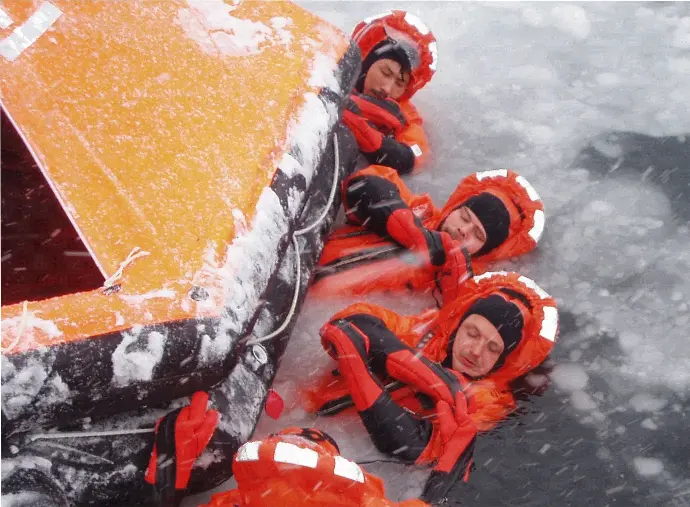Survival Suits
What is a Survival Suit, Anti-Exposure Suit, Immersion Suit or simply a Rescue Suit?
According to SOLAS regulations, survival suits are classified as follows:
Anti-Exposure Suit = Cold water suit / Survival suit
Immersion Suit = Immersion suit
In everyday language, all of these are often referred to collectively as "rescue suits."
The primary purpose of a survival suit is to enable the wearer to withstand harsh conditions while maintaining vital bodily functions. In maritime environments, where accidents at sea can unfortunately occur, survival suits are an essential piece of safety equipment for seafarers and fishermen. These suits are designed to help individuals stay afloat and be easily located and rescued.
A key feature of survival suits is their ability to protect the body from extreme temperatures. In cold waters or icy conditions, they provide insulation and prevent hypothermia. At the same time, they are engineered not to cause overheating in warmer climates.
Modern survival suits often include additional features such as integrated life jackets, signaling devices, and emergency lights. These enhance visibility and significantly increase the chances of survival in an emergency.
On our Website, we offer a carefully selected range of high-quality survival suits that meet the highest safety standards. You’ll find detailed information on various models, their applications, and the latest technological innovations in survival gear. We are proud to offer our customers not just products, but the confidence that they can rely on trusted protective equipment in critical situations.

Maintenance
Maintaining your survival suit is crucial to ensuring it performs reliably and offers maximum protection in emergencies. Key maintenance guidelines include:
Regular Inspections: Inspect the suit regularly for any damage, tears, or signs of wear. Pay special attention to seams, zippers, valves, and cuffs for leaks or deterioration.
Cleaning: Clean the suit thoroughly after each use, especially if it was exposed to saltwater or other contaminants. Use mild soap and warm water. Make sure the suit is completely dry before storing it to avoid mold growth.
Buoyancy Check: Inspect the internal buoyancy components for damage or leaks. Ensure they can be inflated properly and that no air escapes.
Zipper and Closure Lubrication: Lubricate zippers and closures regularly with appropriate lubricant to ensure smooth operation and prevent corrosion.
Replace Worn Parts: Replace worn or damaged components such as zippers, valves, buoyancy elements, or cuffs according to the manufacturer's instructions. Always use original spare parts to maintain safety and functionality.
Documentation: Keep detailed records of all maintenance and inspections, including dates, performed tasks, and replaced parts. This helps track the condition of the suit and plan maintenance accordingly.
By following these guidelines, you can ensure your survival suit is always ready for use and offers reliable protection in emergency situations.
Cleaning
Proper cleaning of survival suits is essential to maintain their performance and extend their service life.
Materials needed:
- Mild detergent or specialized survival suit cleaner
- Soft sponge or brush
- Warm water
- A bucket or tub
- Clean, dry towels
- Optional: small brush for seams and zippers
Preparation: Remove all personal items from the suit and check for visible dirt or stains.
Mix Cleaning Solution: Combine the mild detergent with warm water in a bucket or tub, following productinstructions.
Surface Cleaning: Dip a sponge or brush in the solution and clean the outer surfaces of the suit, focusing on heavily soiled areas. Avoid abrasive cleaners or tools that could damage the material.
Seams and Zippers: Use a small brush to gently clean seams and zippers. Ensure no residue remains that could affect zipper function.
Interior Cleaning: Check the interior for moisture or odors. Wipe with a damp, clean sponge. Let the suit dry thoroughly to prevent mold.
Drying: Hang the suit in a well-ventilated area, avoiding direct sunlight, which can damage the material. Ensure the suit is completely dry before storing.
Final Check: Inspect the cleaned suit for any damage or wear. Repair according to the manufacturer’s instructions if necessary.
Certifications
SOLAS
SOLAS (International Convention for the Safety of Life at Sea) is a major international maritime treaty. In effect since 1974, it sets global safety standards for ships, their crews, and passengers.
It covers a wide range of topics—from navigation rules to emergency equipment such as survival suits—to reduce accidents at sea and improve life-saving measures. SOLAS reflects the international commitment to safe and efficient maritime operations.

ETSO
ETSO stands for European Technical Standard Order. Issued by the European Union Aviation Safety Agency (EASA), these standards apply to civil aviation products in Europe.
An ETSO approval confirms that a product meets the technical and safety requirements for use in aviation.
This certification enhances product reliability and ensures interoperability across the aviation industry.

ISO
The International Organization for Standardization (ISO) sets global standards to ensure products and services are safe, reliable, and of high quality.
In the context of survival suits and life jackets, ISO standards define the design, performance, and testing requirements that such equipment must meet to be considered safe and effective.

FAQs
No, survival suits do not have a fixed expiration date.
SOLAS-certified suits must be inspected every three years. Once a SOLAS suit is older than 10 years, it must be inspected annually.
However, we recommend having all survival suits inspected annually, regardless of their age.
No, fire departments are not legally required to use SOLAS-certified suits. However, we always recommend choosing certified survival suits.
SOLAS sets the global standard for saving lives at sea and a life on land is just as valuable.
Depending on the type and extent of the damage, survival suits can usually be repaired.
Typical repairs include replacing damaged wrist seals, patching small holes, or reapplying reflective tape that has come loose.
- Survival suits should be stored in a dry, cool environment, ideally at temperatures between 10°C and 25°C.
- Avoid direct sunlight and extreme heat sources, as they can damage the material.
- The storage area should be well-ventilated and free from high humidity to prevent mold growth.
- Whenever possible, store the suit hanging to avoid folds or creases that could weaken the material.
- If hanging storage is not possible, place the suit in a designated storage container or protective bag to shield it from dust, dirt, and mechanical damage.
- Do not store survival suits near chemicals, oils, solvents, or other aggressive substances that may degrade the material.
- If the suit is wet after use, it must be thoroughly cleaned and completely dried before storage.


 Survival Suits
Survival Suits